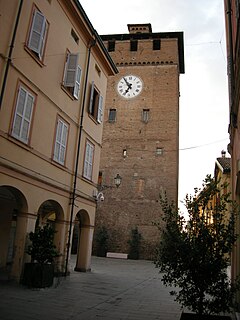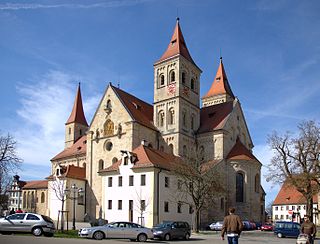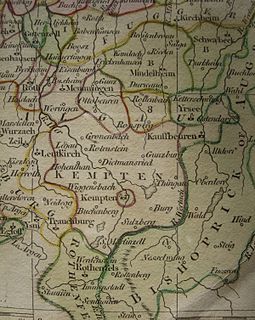Notes
| General | |
|---|---|
| National libraries | |
| Biographical dictionaries | |
| | This article about a German saint is a stub. You can help Wikipedia by expanding it. |
Saint Egino | |
|---|---|
| Born | Augsburg, Bavaria, Germany |
| Died | 1122 Pisa, Italy |
| Venerated in | Catholic Church |
| Major shrine | Carmelite Monastery of St. Michael, Pisa, Italy |
| Feast | 15 July |
Egino was born in Augsburg, Bavaria, Germany, was Camaldolese abbot involved in the many disputes of his era. Egino was placed in the abbey of Sts. Ulric and Afra as a child. [1] He became abbot of the abbey but was expelled when he supported Pope Callistus II against Emperor Henry V in a dispute. Residing in St. Blaise Abbey, he returned to Augsburg in 1106, resuming his office of abbot in 1109. In 1120, Egino fled to Rome because of his opposition to Bishop Hermann, who practiced simony. Returning to Augsburg two years later, he died in Pisa.

Ulrich of Augsburg, sometimes spelled Uodalric or Odalrici, was Prince-Bishopric of Augsburg in Germany. He was the first saint to be canonized not by a local authority but by the Pope.

Nonantola is a town and comune in the province of Modena in the Emilia-Romagna region of northern Italy. It is in the Po Valley about 10 kilometres (6 mi) from Modena on the road to Ferrara.

Ottobeuren is a Benedictine abbey, located in Ottobeuren, near Memmingen in the Bavarian Allgäu, Germany.

Wessobrunn Abbey was a Benedictine monastery near Weilheim in Bavaria, Germany.
St. Stephen's Abbey, Augsburg is a Benedictine monastery, formerly a house of Augustinian canonesses, in Augsburg in Bavaria, Germany.

Ellwangen Abbey was the earliest Benedictine monastery established in the Duchy of Swabia, at the present-day town of Ellwangen an der Jagst, Baden-Württemberg, about 100 km (60 mi) north-east of Stuttgart.
Conrad of Urach was a Cistercian monk and abbot, and Cardinal Bishop of Porto and Santa Rufina; he declined the papacy.

St. Mang's Abbey, Füssen or Füssen Abbey was a Benedictine monastery in Füssen in Bavaria, Germany. It was founded in the 9th century, and dissolved during the post-Napoleonic secularisation of Bavaria.

St John's Abbey, also called Colchester Abbey, was a Benedictine monastic institution in Colchester, Essex, founded in 1095. It was dissolved in 1539. Most of the abbey buildings were subsequently demolished to construct a large private house on the site, which was itself destroyed in fighting during the 1648 siege of Colchester. The only substantial remnant is the elaborate gatehouse, while the foundations of the abbey church were only rediscovered in 2010.

Saint Simpert was an abbot, bishop, and confessor of the late-8th and early-9th centuries, and was supposedly the nephew of Charlemagne. He was educated at Murbach Abbey in Alsace, where he took the Benedictine habit and was elected abbot. In 778, he was appointed bishop of Augsburg by Charlemagne. He consolidated and strengthened the jurisdiction of his bishopric and lived alternately at Neuburg an der Donau, at Staffelsee Abbey, and at Augsburg.

St. Ulrich's and St. Afra's Abbey, Augsburg is a former Benedictine abbey dedicated to Saint Ulrich and Saint Afra in the south of the old city in Augsburg, Bavaria.
Egino may refer to:

The Princely Abbey of Kempten was an ecclesiastical principality of the Holy Roman Empire for centuries until it was annexed to the Electorate of Bavaria in the course of the German mediatization in 1803.
Roger Norreis was Abbot of Evesham in England. He was a controversial figure, installed in several offices against opposition. In his appointment to Evesham, he was accused of immoral behaviour and failing to follow monastic rules. In 1202, Norreis became embroiled in a dispute with his monks and his episcopal superior the Bishop of Worcester; litigation and argumentation lasted until his deposition in 1213. He was then appointed prior of a subsidiary monastic house of Evesham, but was deposed within months, then re-appointed to the office five years later.

Viktor Josef Dammertz was a German Benedictine monk of St. Ottilien Archabbey located in Bavaria, Germany, which is part of the Benedictine Congregation of Saint Ottilien. He was elected and served as the sixth Abbot Primate of the Benedictine Confederation of the Order of Saint Benedict from 1977-1992. He was nominated by Pope John Paul II as Bishop of the Diocese of Augsburg 24 December 1992, consecrated 30 January 1993, and resigned 9 June 2004.
Wolfleoz von Konstanz, or Wolleozzus was bishop of the Bishopric of Konstanz from 811 to 838/39 and abbot of the Abbey of Saint Gall from 812 to 816.
Werdo was abbot of the Abbey of Saint Gall in St. Gallen.
Craloh was abbot of the Benedictine Abbey of Saint Gall from 942 to 958. During his time in office, the first anti-abbot was elected.
Heinrich von Gundelfingen was abbot of the Abbey of Saint Gall from 1411 to 1418 when he resigned. He was the grandfather of Heinrich von Gundelfingen.

Egino IV, also written as Egeno or Egon, and called the Bearded, was Count of Urach from 1181 to 1230 and co-ruler of the County of Frieburg with his son Egino V from 1218 to 1230.